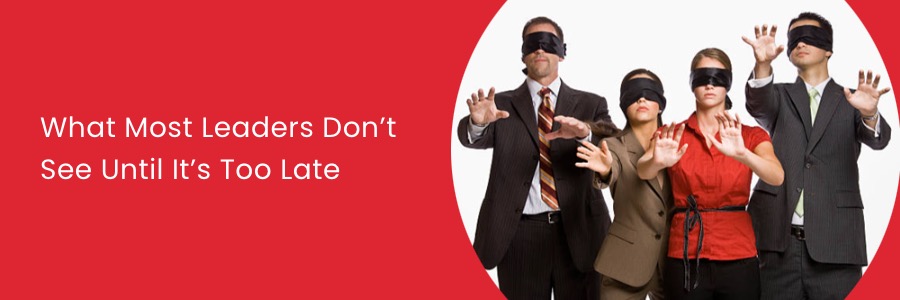‘Your blind spots don’t wait for your permission to cause damage.’
Let’s be honest. Every leader has blind spots.
And not the ‘Oh, I forgot to include you in that meeting’ kind.
I’m talking about the behavioural blind spots. The ones that silently sabotage trust. That trigger disengagement in teams. That fracture collaboration, spark conflict, and slowly erode influence – without you even realizing it’s happening.
Because here’s the thing most leaders don’t understand until it’s too late:
Your blind spots don’t wait for your awareness. They’re already shaping your culture. And usually not in a good way.
What Is a Behavioural Blind Spot?
It’s the gap between how you think you lead and how others experience your leadership.
You might think you’re being clear…
Your team thinks you’re being vague.
You might believe you’re approachable…
But your team hesitates to speak up around you.
You might see yourself as decisive…
They see a pattern of abrupt, top-down decisions with no context or collaboration.
These blind spots are often invisible to you but felt deeply by others.
And that’s why they’re so dangerous.
Here’s the Problem:
Most leaders don’t go looking for their blind spots.
Why?
Because it’s uncomfortable.
Because they’ve been praised for results, promotions, and business growth – without ever being challenged on how those outcomes were achieved.
But in the modern workplace, that mindset doesn’t work anymore.
Today’s teams crave authenticity, clarity, and connection.
Not command-and-control. Not ego. Not performance at the cost of people.
Where Blind Spots Show Up:
In communication:
You think you’re being direct. They feel dismissed.
In pressure and stress:
You think you’re being decisive. They experience emotional volatility.
In collaboration:
You think you’re delegating. They feel micromanaged.
In feedback:
You think silence means alignment. They’ve actually given up trying to be heard.
And here’s the truth: No one is going to tell you.
Because you’re the boss.
Because they fear the reaction from you.
Because they’ve tried before and nothing changed.
The Leadership Cost of Blind Spots
Let’s break it down:
Trust breaks down when leaders say one thing but do another.
Engagement drops when team members feel unseen, unheard, or undervalued.
Collaboration suffers when leaders dominate rather than facilitate.
Inspiration dies when purpose is replaced with pressure.
And when these elements start to unravel, the workplace shifts – People disengage, they check-out.
Good talent leaves.
And performance plateaus or declines, even if everything “looks fine” on the outside.
But There’s Good News:
Blind spots don’t have to be permanent.
In fact, the most respected, trusted, and effective leaders are the ones who intentionally seek them out.
They don’t wait for a 360 review to learn how their behaviour impacts others.
- They ask early.
- They ask often.
- They seek feedback.
- And most importantly—they act on what they hear.
This is the Shift:
From blind spots → to Behavioural Intelligence.
From unconscious default reactions → to intentional, emotionally intelligent responses.
From ‘this is just how I lead’ → to ‘is this behaviour actually working?’
Because leadership excellence doesn’t come from perfection.
It comes from self-awareness, humility, and the courage to evolve.
Real Talk: My Own Blind Spot
There was a time in my leadership career when I thought I was ‘direct’ and ‘efficient.’
I was praised for results. But my team?
They felt intimidated. Dismissed. Shut down.
I had no idea.
Until one brave soul said, ‘Preetie, we’re not sure if you actually want our input – or if you’ve already made up your mind – why are we even having this meeting.’
That moment hit hard. But it woke me up.
I wasn’t leading through clarity. I was leading through control. That was the blind spot.
From that point forward, I committed to shifting – Slowing down. Listening more. Creating space for different voices. Leading with presence, not pressure.
And what happened?
Engagement lifted.
Collaboration deepened.
Results improved.
Because when behaviours shift – everything shifts.
A Tool for the Shift: The Shiftcode Model
That experience inspired me to create the Shiftcode Model –
A framework designed to help leaders uncover and shift their behavioural blind spots, fast. It’s not theory. It’s lived.
It’s not about judgement. It’s about evolution.
The model maps where behaviours are anchored, reactive, adaptable, or intentional – so leaders can stop flying blind and start leading with behavioural intelligence.
So, What Can You Do Today?
Here are 3 steps to start identifying your blind spots:
Ask, don’t assume.
Try: ‘What’s one thing I can do better as your leader?’
Listen without defending.
Feedback is a gift. Don’t return it unopened.
Reflect consistently.
After every meeting, ask yourself: ‘Did I listen or just talk? Did I invite dialogue or dominate it? Did I react or respond?’
These aren’t complicated practices –
But they require intention, courage, and repetition.
My Final Thought:
Your leadership isn’t defined by your title. It’s defined by how people feel after working with you.
- If they feel safe.
- If they feel seen.
- If they feel inspired to contribute at their best.
That’s leadership.
So let me leave you with this:
What’s one blind spot you’ve worked hard to shift – or one you’re ready to uncover?
Because the shift doesn’t start when everything is perfect.
It starts the moment you’re willing to look inward.



